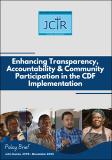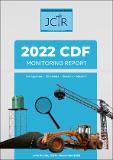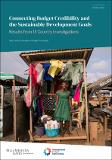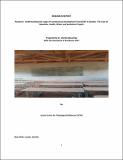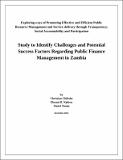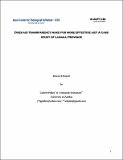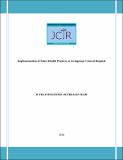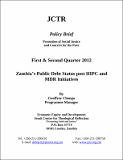Studies
Browse by
Recent Submissions
-
Identifying and Analysing Challenges in Accessibility of the Constituency Development Fund (CDF) Loans and Grants Among Women and Youths in Rural Communities: A Case of Mansa and Samfya Districts
(2024-04-14)This study, conducted by the Jesuit Centre for Theological Reflection (JCTR) in collaboration with the Zambian Financial Sector Deepening Limited (FSD Zambia), investigates the barriers hindering women and youths in rural ... -
Enhancing Transparency, Accountability & Community Participation in the Implementation of the Constituency Development Fund
(2023-12-07)Following the enhancement of the Constituency Development Fund (CDF) budgetary allocation from K1.6 million to K25.7 million in 2022, and subsequently to K28.3 million in 2023, civil society expressed concern at the lack ... -
2022 Constituency Development Fund (CDF) Monitoring Report: Chisamba, Kasama, Livingstone & Masaiti Constituencies.
(2023-12-07)The Jesuit Centre for Theological Reflection (JCTR) conducted a Constituency Development Fund (CDF) monitoring exercise in May 2023 in four select constituencies to systematically collect information on the CDF processes ... -
Connecting Budget Credibility and the Sustainable Development Goals : Results from 13 Country Investigations
(2022-10-30)Budget credibility is a challenge found in many developing countries. It is defined as the difference between the budget that is approved by a country’s legislature, the actual expenditures spent, and revenues collected ... -
Understanding the usage of Constituency Development Fund (CDF) in Zambia: The Case of Education, Health, Water and Sanitation Projects
(2019-05)Constituency Development Fund (CDF) is the generic name for a policy tool that dedicates public money to benefit specific political subdivisions through allocations and/or spending decisions influenced by their representatives ... -
Study to Identify Challenges and Potential Success Factors Regarding Public Finance Management in Zambia
(2011-12)This study was commissioned by the Jesuit Centre for Theological Reflection (JCTR) to explore ways of promoting effective and efficient public resource management and service delivery through transparency, social accountability ... -
Final Report of the Evaluation of the Debt Project (October 1998-December 2001)
(2003-03-04)The CCJP/JCTR debt project was established in 1998 with the purpose of securing an ethical outcome to Zambia’s external debt problem, viewed as a burden on the people by the project holders. The main purpose of the evaluation ... -
The Taxation System in Zambia
(2011-01)Zambia is facing tax performance challenges that need to be addressed urgently. The declining tax performance in the recent past has been caused by the proliferation of tax incentives in Zambia. The premise of this study ... -
Debt Resource Monitoring Report (DRM)
(2010-11)The poor water supply and sanitation situation in the Central Province resulted the Zambian government to acquire a loan and grant amounting to US$33 million from the African Development Bank (AfDB) to embark on a US$36.9 ... -
Does Aid Transparency Make for More Effective Aid? A Case Study of Lusaka Province
(2011)The movement for increasing aid transparency has gained significant momentum in recent years. The purpose of this study is to analyze the link between aid transparency and aid effectiveness. Several studies do not corroborate ... -
Implementation of Select Health Projects at Livingstone Central Hospital
(2018)Over the years, the Jesuit Centre for Theological Reflection (JCTR) has monitored the use of public financial resources in an effort to foster accountability by public officers. Some works have included analysing issues ... -
An Assessment of The Problems / Obstacles Faced By Informal Cross Border Traders in Zambia: The Case For Chipata And Livingstone Towns
(2002)This study assesses the problems / obstacles faced by informal cross border traders in Zambia, using Chipata and Livingstone towns as case studies. The; study ’was done with the understanding that Zambia is part of the ... -
Economic Partnership Agreements: A Challenge for Trade Justice
(2007)In the last three years, the Debt and Trade Project (now Debt Aid and Trade Programme, DAT) of the Jesuit Centre for Theological Reflection (JCTR) invested in understanding the trade challenges faced by Zambia and other ... -
Zambia’s Public Debt Status Post HIPC And MDR Initiatives
(2012)The Public Debt reforms that the Zambian Government embarked on in 2004 aimed at strengthening debt management capacities of various Government institutions engaged in debt management should be accelerated. Currently, the ... -
Understanding the Usage of Constituency Development Fund (CDF) in Zambia: The Case of Education, Health, Water and Sanitation Projects In Chishipula, Kapulanga, Chamboli and Simoonga Communities
(2019-07)In Zambia, the Constituency Development Fund (CDF) was introduced in 1995 as “instrument” to facilitate the deliverance of public developmental goods and services directly to local communities. Despite the introduction of ... -
An Evaluation of The Strengths And Weaknesses of Public Debt Management in Zambia And Management Legal Review
(2007-11)Zambia’s external debt has had a number of effects on the Zambian economy. The HIPC debt agreement, coined in 1996 to help countries like Zambia faced with a huge debt problem and a high fiscal deficit resulted in Zambia ... -
Human-Needs Based Debt Sustainability Analysis: A Challenge For Zambia
(2005-06)In this report. Jubilee Zambia presents a proposal of a set of guides on the development of a human- needs based Debt Sustainability Analysis Framework (DSA.). This proposal is formulated with a view to stimulate dialogue ... -
Cost Benefit Analysis of Employment Created By Zambia Agribusiness
(2013-03)Zambia is endowed with abundant natural resources, but in spite of the nation’s potential the problems of unemployment, underemployment and poverty have not been meaningfully alleviated by substantial investment and a fast ... -
Debt Resource Monitoring Report
(2010-11)Good road infrastructure is cardinal in the promotion of viable economic activities. This is even more so for the agriculture sector which relies on the road network for transportation of agricultural inputs such as seed ...


